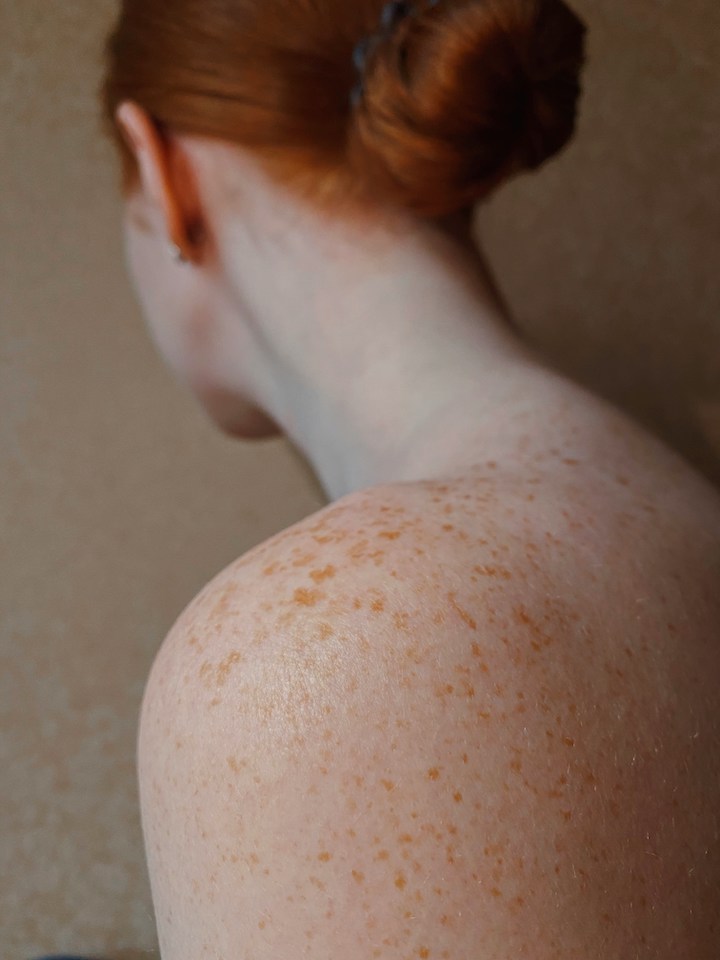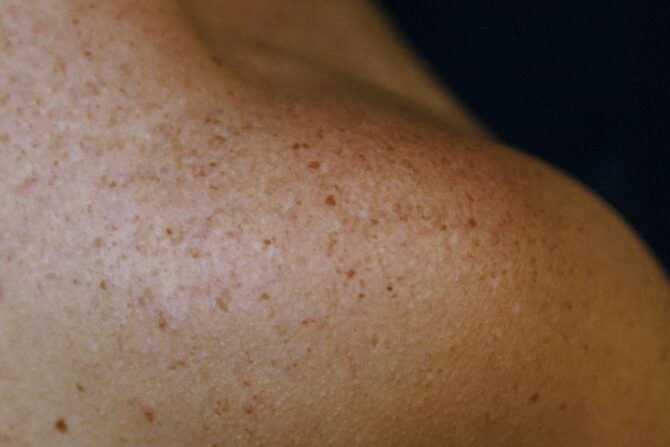Have you ever looked at your legs after shaving and noticed tiny dark dots — like the seeds on a strawberry? Yeah, that’s what most people call strawberry skin. And let me just say this: if you’ve got it, you’re not alone.
It’s one of those things that almost no one talks about, but so many of us deal with. I used to wonder what I was doing wrong, why my legs didn’t feel as smooth as they looked in the mirror. Turns out, it wasn’t just me. And if you’re going through the same thing, there’s nothing wrong with you either.
Now here’s the good part — strawberry skin treatment exists. Gently. From home. Without expensive treatments or harsh scrubbing that makes your skin feel worse. So let’s walk through it together.
Table of Contents
What Causes Strawberry Skin?
First, it helps to understand why this is even happening in the first place. Once you know what’s causing it, the rest starts to make more sense.
- Shaving with dull razors: You know those times when you use the same razor one too many times? Yeah, that’s usually when those little dots show up.
- Clogged pores or hair follicles: Think of them like tiny traps that hold onto oil, dead skin, and debris. Over time, that buildup darkens.
- Dead skin cells: When they’re not exfoliated off gently, they sit on top of your skin and make it harder for hair to grow out properly.
- Dryness: If your skin is too dry, the outer layer can harden. That makes it easier for hairs to get trapped — and for pores to get clogged.
- Genetics and keratosis pilaris: For some people, it runs in the family. You didn’t cause this. It just happens.
So no, strawberry skin doesn’t mean you’re dirty or doing something wrong. It means your skin needs a little help clearing out the clutter — and a bit more moisture.

How to Know If You Have It
Sometimes we don’t even realize we’re dealing with it. So here’s what to look out for:
- Tiny dark dots on your legs, especially around the calves or thighs. They look like the skin of a strawberry.
- Rough patches, usually where you shave often.
- Bumpy texture, even after exfoliating.
If that sounds familiar, you’re in the right place. Let’s talk about what not to do first.
Also Read: The Ordinary Skincare Set: My Personal Recommendation
What Not to Do First
Before we get into what helps, let’s talk about what doesn’t. Trust me, I’ve tried a lot of these things in the past — and they didn’t end well.
- Don’t scrub like your life depends on it. That only irritates your skin and makes things worse.
- Don’t keep using the same old razor. Even if it looks okay, if it drags, toss it.
- Don’t skip moisturizer, even if your skin feels oily.
- Don’t use drying soaps or harsh body washes.
You don’t need to attack your skin to make it better. You just need a steady routine that treats it gently and gives it time.
Step-by-Step Strawberry Skin Treatment Routine
Let’s get into the good stuff — what actually helps. This is the routine I follow, and it made a real difference once I gave it a little time.
Step 1: Soften Your Skin First
Before you even think about shaving, make sure your skin is warm and soft. A short warm shower or bath can help. You can also use a gentle body cleanser that doesn’t strip away your skin’s natural oils.
Step 2: Exfoliate the Right Way
There are two ways to exfoliate — physical and chemical — and you don’t need to choose just one. But don’t overdo either.
Physical exfoliation:
Use a sugar scrub or a dry brush twice a week max. Dry brushing before your shower works best. Scrub in gentle circles — you’re not sanding a table.
Chemical exfoliation:
This changed everything for me. Look for body lotions or toners with salicylic acid or lactic acid. These dissolve dead skin gently and help unclog pores. Use them every other day if your skin can handle it.
Step 3: Shave Smart
This is where most strawberry skin problems start — and where they can be stopped too.
- Use a fresh, clean razor. Always.
- Shave in the direction your hair grows, not against it.
- Use a moisturizing shave gel or natural oil. Coconut oil or olive oil work too if you want to keep it simple.
If you’re dry shaving or rushing through it, that’s probably making things worse. Give your skin time. It’s not a race.
Step 4: Moisturize Right After
While your skin is still slightly damp, apply a moisturizer that helps restore the skin barrier. Look for ones with:
- Urea
- Ceramides
- Glycerin
Stay away from heavily fragranced lotions. They might smell great, but they can make your skin itchy and dry — which just brings the bumps back.
Step 5: Be Consistent
No treatment works overnight. But this routine, done regularly, can absolutely change the way your skin looks and feels. Stick with it. Even if you don’t see results after the first week, keep going. It’s working under the surface.
What to Use (And What to Avoid)
Let’s break it down — what helps, and what just gets in the way.
🌿 Good Ingredients to Look For
- Salicylic acid – unclogs pores
- Lactic acid – smooths skin
- Urea – hydrates and exfoliates gently
- Niacinamide – soothes and repairs
🚫 Avoid These
- Alcohol-heavy lotions – they dry you out
- Highly perfumed products – they often cause irritation
- Scrubs with sharp bits – they can tear your skin
If it burns, stings, or feels like too much, it probably is.
Simple Home Remedies You Can Try
You don’t always need fancy products. A few things from your kitchen can help too.
- Sugar + Olive Oil Scrub:
Mix equal parts and gently rub in circles before your shower. - Oatmeal + Honey Soak:
Blend oatmeal into powder, add a spoon of honey, and soak in warm water for 10–15 minutes. - Diluted Apple Cider Vinegar:
Use it as a gentle toner once or twice a week. Always dilute with water. - Aloe Vera Gel:
Apply it after shaving to calm the skin. Store it in the fridge for extra soothing power.
These won’t replace exfoliating acids or moisturizers completely, but they can support your routine when used once or twice a week.

How Long Until You See Results?
Okay, here’s the part where patience comes in. Your skin isn’t going to completely change in a few days. But…
- After 1 week: You might feel less roughness.
- After 2–3 weeks: You’ll notice fewer bumps and less redness.
- After 4–6 weeks: The dark spots should fade, and skin starts to look clearer.
The key is to stay consistent. This isn’t a quick fix. It’s a slow transformation — but it works.
Check Out: Hair Styling Product Formulation: Awesome Things You Need to Know Before You Buy Anything
When to See a Dermatologist
If nothing is helping, or things are getting worse, don’t try to “push through it.” There’s no shame in needing help.
- If the bumps are painful or inflamed
- If you’ve tried multiple routines for months with zero results
- If your skin is making you feel anxious or self-conscious — that alone is reason enough
Sometimes, strawberry skin is part of a skin condition like keratosis pilaris, and a dermatologist can help with prescription creams that work faster and more deeply.
Conclusion
So there you have it — a full guide to treating strawberry skin gently, naturally, and consistently.
If you’ve been wondering how to get rid of those little dots on your legs, I hope this gives you answers. And more than that, I hope it helps you feel more in control of your skin again.
Don’t feel pressured to fix it overnight. You’re not broken. Your skin just needs a little extra care — and you now know exactly how to give it that.
Frequently Asked Questions
Can strawberry skin go away completely?
It can fade a lot with the right routine. While it might not disappear entirely for everyone, most people see huge improvements with consistent care.
Is it okay to shave every day if I have strawberry legs?
It’s better to shave every few days. Daily shaving can irritate your skin and make the bumps worse, especially if your razor isn’t sharp.
What’s the best lotion for strawberry skin?
Look for one with urea, ceramides, or lactic acid. These ingredients hydrate and gently exfoliate without causing irritation.
Can I exfoliate daily to fix it faster?
No — daily exfoliation can actually backfire. Stick to 2–3 times a week for physical scrubs and every other day for chemical exfoliants, depending on how your skin reacts.



